 There are many .22 caliber rifles that you cannot simply take out of the box and expect to hit anything with any degree of accuracy; they require that an optic be mounted – magnified or otherwise.
There are many .22 caliber rifles that you cannot simply take out of the box and expect to hit anything with any degree of accuracy; they require that an optic be mounted – magnified or otherwise.
For my Ruger 10/22 “Target” project I selected a Nikon PROSTAFF Rimfire II 3-9×40 rifle scope, since I have peered through one like it that was mounted on a .22 caliber Anschutz rifle owned by my favorite shooting companion, and have also mounted a Nikon PROSTAFF Rimfire II 4-12×40 on the Ruger American Rimfire 22LR.
The Nikon PROSTAFF Rimfire II 3-9×40 is simply a better unit for my indoor endeavors, but can be used for longer distance shooting should I get to move outdoors with the rifle or at an indoor range with 100-yard capabilities. I am going to get into details shortly.
Since Ruger provide the sight base, and its finish matches the receiver, I decided to go with it. Ruger ships a Weaver-style rail with an integrated conventional 3/8” dovetail, which leaves the scope mounting choice up to the user. I selected the Weaver-style portion of the base due to its more stable platform. Some assembly; however, is required prior to mounting the scope. Ruger provides instructions for mounting the bases in the Instruction Manual that comes with the firearm. Note that a torque screwdriver, like “The Fat Wrench” is required to apply the correct amount of torque to the base mounting screws. The last thing that you need is to snap off a mounting screw during assembly. Sight base screws are to be tightened between 15 to 25 inch pounds, according to Ruger.
A set of matte finish, Leupold 1” Rifleman Detachable Rings with a medium height would do the duty of securing the Nikon PROSTAFF Rimfire II 3-9×40 scope to the receiver. The “medium” height rings place the center of the scope perfectly at my eye level with a proper cheek weld and also provides plenty of barrel clearance for the 44mm objective lens housing. The scope was set for eye relief, leveling was performed, and all screws were torque to 15-inch pounds. With the Ruger 10/22 Target model, recoil is definitely not an issue.

 To put things into perspective, the Ruger 10/22 Target model, with the PROSTAFF Rimfire II 3-9×40 rifle scope, weighs in at roughly 8.32 pounds, which is roughly 1.5 pounds less than a Springfield M1A with a walnut stock. Add another nine or so ounces for a bi-pod and you have a robust firearm platform.
To put things into perspective, the Ruger 10/22 Target model, with the PROSTAFF Rimfire II 3-9×40 rifle scope, weighs in at roughly 8.32 pounds, which is roughly 1.5 pounds less than a Springfield M1A with a walnut stock. Add another nine or so ounces for a bi-pod and you have a robust firearm platform.
At this point, allow me to present to you the “why” of selecting a scope like the PROSTAFF Rimfire II 3-9×40 BDC 150 over numerous scope available to us today.
First, let’s take a look at some basic specifications for the PROSTAFF Rimfire II 3-9×40 BDC 150
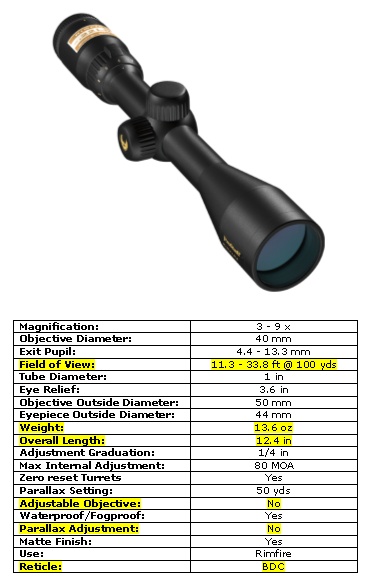
Physical dimension are shown below:
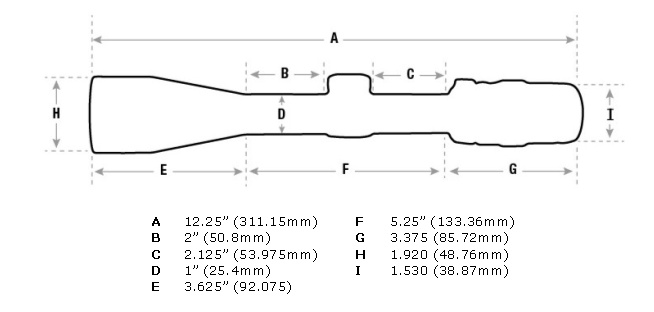
First of all, with ¼ MOA adjustment at 50 yards, one might notice that this scope is intended for use with the rimfire cartridge. My normal shooting distance is at twenty-five yards at my local indoor range, and twenty-five yards is my zero distance. With a conventional scope calibrated for larger calibers, with a ¼ MOA at 100 yards, I would need to move elevation or windage adjustments 16 clicks to move the impact 1 inch on the paper. With the PROSTAFF Rimfire II 3-9×40 BDC 150, I only need 8 clicks to move the impact 1 inch on the target. That is a lot less work on my part. At fifty yards, I only need 4 clicks of adjustment for a 1” shift in bullet impact. With a conventional scope, I would need to dial in 8 clicks of adjustment for the same amount of shift.
The fit and finish of the PROSTAFF Rimfire II 3-9×40 BDC 150 is impeccable and is in satin black (Matte), which seems to be the common theme these days.
While I don’t concern myself with eye relief too much with a .22 caliber firearm, the 3.6 inches of eye relief is nice to have.
Magnification adjustment is quite simple using the tab that is integral to the adjustment ring.
Just rearward of the magnification adjustment ring is the focus locking ring that is used to lock-in the eyepiece (ocular lens) housing.
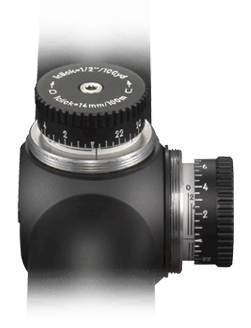 Elevation and windage adjustment turrets are protected by removable plastic covers, which is more common than not. The elevation and windage adjustment turrets are finger-adjustable, which is a big plus over using a small screwdriver or coin. One feature that I truly appreciate is the Spring Loaded Instant Zero-Reset Turrets. To simplify field adjustments, Nikon has integrated this feature into the rifle scope. Just sight-in as usual, then lift the spring-loaded adjustment knob, rotate to your “zero”, and release the knob to re-engage. Field adjustments are now as simple as dialing-in your subsequent ranges (I’ll talk about the “Spot On” application shortly). If you wish to return to your original zero, simply turn the knob until the “zero” aligns with the indicator.
Elevation and windage adjustment turrets are protected by removable plastic covers, which is more common than not. The elevation and windage adjustment turrets are finger-adjustable, which is a big plus over using a small screwdriver or coin. One feature that I truly appreciate is the Spring Loaded Instant Zero-Reset Turrets. To simplify field adjustments, Nikon has integrated this feature into the rifle scope. Just sight-in as usual, then lift the spring-loaded adjustment knob, rotate to your “zero”, and release the knob to re-engage. Field adjustments are now as simple as dialing-in your subsequent ranges (I’ll talk about the “Spot On” application shortly). If you wish to return to your original zero, simply turn the knob until the “zero” aligns with the indicator.
TUNNEL VISION:
The one thing that you will notice when looking through the looking glass is the clarity and light-gathering characteristics of the glass.
Nikon scopes are known for their clarity and the PROSTAFF Rimfire II 3-9×40 BDC 150 is no exception. Even under indoor range lighting, the PROSTAFF Rimfire II 3-9×40 BDC 150 performs very well. In natural, outdoor lighting the scope is impressive.
Multiple layers of anti-reflective com-pounds on every glass surface provide bright and vivid sight pictures and opti-mum light transmission and maximum brightness from dawn to dusk. The PROSTAFF Rimfire II 3-9×40 BDC 150 is Nitrogen-purged and O-ring sealed.
THE BDC RETICLE:
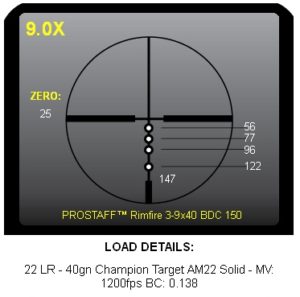 The PROSTAFF Rimfire II 3-9×40 BDC 150 incorporates a BDC reticle. For the most part, as I point out in my article BDC Rifle Scopes Fact and Fallacy (https://guntoters.com/blog/2016/12/14/bdc-rifle-scopes/), are relatively useless unless you can understand, and work with, all of the factors that make a BDC scope work to your advantage.
The PROSTAFF Rimfire II 3-9×40 BDC 150 incorporates a BDC reticle. For the most part, as I point out in my article BDC Rifle Scopes Fact and Fallacy (https://guntoters.com/blog/2016/12/14/bdc-rifle-scopes/), are relatively useless unless you can understand, and work with, all of the factors that make a BDC scope work to your advantage.
Like a sport, a BDC reticle is only effective if you know how to play the sport. Dressing up in a football uniform does not necessarily mean that you are a football player. For years, shooters have shot successfully without BDC reticles by knowing how much deviation was needed from POA to impact at the desired POI at varying distances and environmental conditions. I have heard and read plenty of complaints by shooters with BDC, MOA, and MIL Dot scopes with the major complain being that they can’t hit doo-doo with said scope using the BDC markers. Primarily, their complaints stem from their own ignorance on how to use the BDC features, but it is far easier than faulting the scope rather than themselves.
Fortunately, Nikon has the “Spot On” program that can greatly assist the shooter in understanding BDC. The Spot On program is nothing magical; it simply takes ballistic data and presents it in a usable form so that the shooter can decide what needs to be changed to make that perfect shot.
SPOT-ON TECHNOLOGY:
As stated by Nikon:
Match your riflescope and reticle to virtually any ammunition. All you need is a rifle, a Nikon riflescope and a rangefinder—Spot On does all the work for you—showing you all the shot possibilities before you pull the trigger! With an expansive database Spot On provides you with the precise aiming points at your specified range for any Nikon BDC reticle riflescope and instant reference for sighting in other Nikon riflescopes with plex, mildot or standard crosshair reticles.
With the above said, it must be understood that anything and everything affects the value of the BDC markers. If you are in the field, the SPOT On application is available for iPhone and Android. With that said, the Nikon “Spot On” program is the most complete software that I have found (so far) for tailoring scope-to-cartridge.
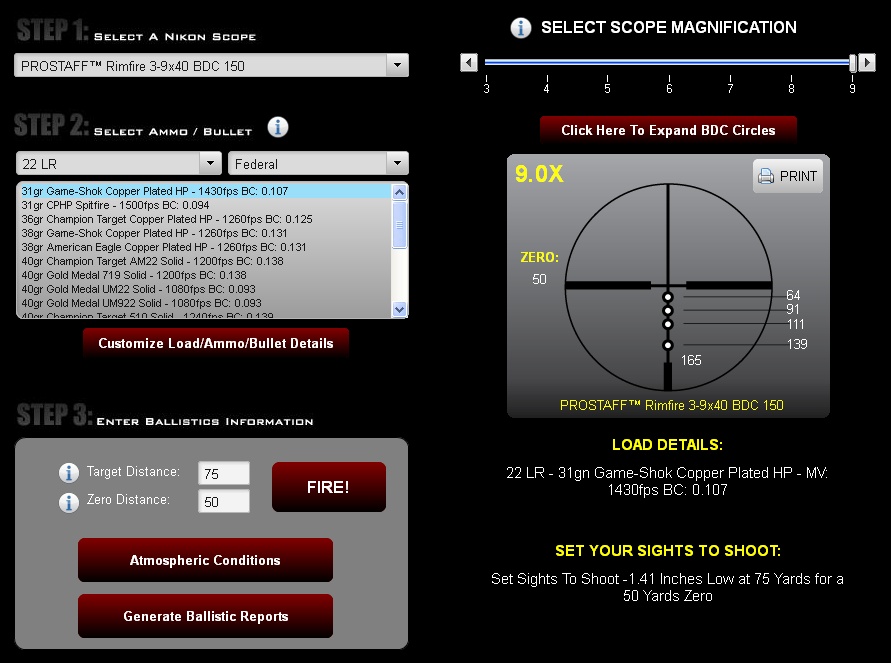 The Spot On program allows me to enter as much or as little data that I need to make a shot. For example; I am shooting a .22 caliber rifle with the PROSTAFF Rimfire II 3-9×40 BDC 150 mounted and zeroed for fifty yards. I refer to my GPS for my location that also provides me with elevation (1, 047 feet). My target is 150 yards down range and there is a 3 mph wind coming in from the North East. My weather app tells me that it is 72 degrees with a relative humidity of 43 per cent. Note that when I enter the elevation, the program will ask me if I wish to allow the program to set the barometric pressure for the altitude. I answer “Yes” and the program does the rest. The target and I are on almost the same plain so I do not have to worry about the angle of the shot.
The Spot On program allows me to enter as much or as little data that I need to make a shot. For example; I am shooting a .22 caliber rifle with the PROSTAFF Rimfire II 3-9×40 BDC 150 mounted and zeroed for fifty yards. I refer to my GPS for my location that also provides me with elevation (1, 047 feet). My target is 150 yards down range and there is a 3 mph wind coming in from the North East. My weather app tells me that it is 72 degrees with a relative humidity of 43 per cent. Note that when I enter the elevation, the program will ask me if I wish to allow the program to set the barometric pressure for the altitude. I answer “Yes” and the program does the rest. The target and I are on almost the same plain so I do not have to worry about the angle of the shot.

Set Environmental Data
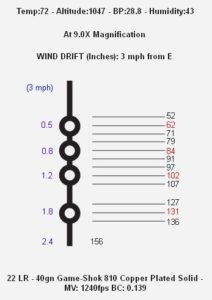
Expanded Reticle View
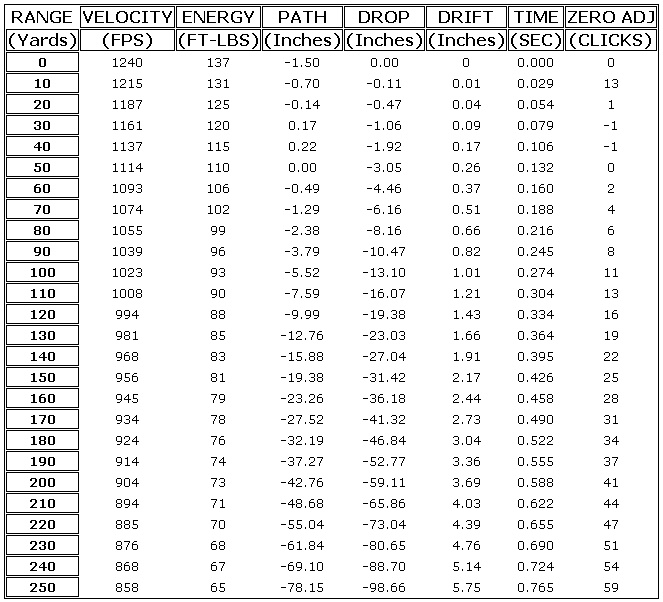
Ballistics Data
SCOPING IT OUT:
It seems like, these days that we not only need a good magnified optic but we also need inputs from various devices to tell us how to shoot. Range finders, ballistic software, GPS, an environmental station to provide information regarding wind direction and speed, relative humidity, can’t hurt in making that “perfect” shot.
The PROSTAFF Rimfire II 3-9×40 BDC 150 is mounted atop a Ruger 10/22 Target rifle. The PROSTAFF Rimfire II 3-9×40 BDC 150 is an excellent scope and very reasonably priced. In fact, I have a second PROSTAFF Rimfire II 3-9×40 BDC 150 waiting in the wings for the right .22 rifle to come along.
DON’ Jus’ TAKE MY WORD FOR IT:
- Nikon Prostaff Rimfire Rifle Scope 3 9×40: https://www.youtube.com/watch?v=wH-Jf4aLo6c
- Review: Nikon Prostaff Rimfire 3-9×40 BDC 150: https://www.youtube.com/watch?v=4pD2IBVFZvI
- Nikon ProStaff Rimfire 3×9-40 Scope: https://www.youtube.com/watch?v=LJDAjiLvnpI
- Nikon Prostaff Rimfire Review: https://www.youtube.com/watch?v=7MY_NPRirxI
RESOURCES:
PROSTAFF RIMFIRE II 3-9×40 BDC 150: http://www.nikonsportoptics.com/en/nikon-products/riflescopes/prostaff-rimfire-ii-3-9×40-bdc-150.html
![]()

